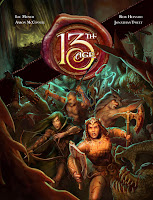Pathfinder Roleplaying Game by Paizo Publishing, LLC
Pathfinder is not a new development within the tabletop RPG community. However, it is currently the market leader and continues to make big steps into the market. Right now, with very few other people really vying for the Dungeons & Dragons player base, Pathfinder has done well in "converting" people to their game. But what game is it?
| Find your Path. |
As an option for fantasy role-playing, Pathfinder is a viable choice because it has a developer who continues to support the game with adventure paths, additional game features, and a host of other novel products. The organized play organization, the Pathfinder Society, feels a lot more like the old D&D organizations (Living Greyhawk, Living Forgotten Realms), a system that can be intimidating for new players. Luckily, the Pathfinder community grew out of the remnants of the D&D3.5 player base, so finding a group is usually not that hard.
13th Age by Fire Opal Media
13th Age is an upcoming role-playing game developed by two "veterans" of the D&D scene, Jonathan Tweet and Rob Heinsoo. People may recognize those two names (or, comically, radical D&D fans may only recognize one of them). Jonathan Tweet was one of the three principal author/designers of the Third Edition core rulebooks while Rob Heinsoo was one of the lead author/designers of the Fourth Edition core rulebooks. In addition, Keith Baker (of Eberron fame) helped with some of the original design concepts.
What does this mean for 13th Age? People who backed it (either via the Escalation Edition pre-order or via the expansion Kickstarter) already have a glimpse of what to expect. 13th Age sits in a space that would likely make parts of both the 3/3.5 community and 4E community content. However, it's not the 3/4E pedigree that is most interesting about 13th Age. What makes 13th Age interesting is a lot of the things that are NOT 3/4E that is most compelling.
Jonathan Tweet and Rob Heinsoo have taken a lot of inspiration from the indie RPG community in developing 13th Age. Although it still has its roots very much in the D&D bloodline, some of the little things make it really stand out. Characters build ties, both good and bad, to the 13 "icons" of the world, with mechanical considerations for how that can relate to specific situations. Characters spend points on different backgrounds that are used instead of specific skills. Every character has "one unique thing" that sets them apart from the rest of the world. There are a lot of little things about 13th Age that set it apart from its predecessors in a very good way.
All of these features help shape 13th Age as a game that intends to sit somewhere between the classic world of D&D and the indie RPG community. Some elements of the game have already made it into my D&D campaigns at home. I expect to see 13th Age as the game for fans of D&D who are willing to try out some interesting variations to the game but who still want to keep some of the basic core of the D&D game. Expect it somewhere at the end of the year.
Other Games (Dungeon World, Dungeon Crawl Classics, and more)
There are other games out there worth taking a look at. Dungeon World, by Sage Kobold Productions, uses the rules developed in Apocalypse World and tailors them for a fantasy world akin to Dungeons & Dragons. It is a "indie RPG" insomuch that it deviates from the accepted norm of fantasy RPGs. That does not mean it is not a great idea. I suspect a game like Dungeon World accomplishes a lot of the things that the big public playtest for D&D is trying to do. Dungeon World is a game with some solid game mechanics that emphasizes exploration, role-playing, and combat in a powerful way. For those that are unfamiliar with it, I recommend asking your local game store to order it when it becomes available.
 |
| Now, with 40% more tables! |
There are other games, of course. Old classics like Steve Jackson's GURPS or Pinnacle's Savage Worlds can do a fantasy setting just fine. Those interested in reliving the less pleasant aspects of the 1980s could investigate Palladium Fantasy Roleplay. Even old editions of Dungeons & Dragons can be found at used bookstores and game shops (or, as Wizards of the Coast permits, reprinted at your local gamestore). So, as Dungeons & Dragons heads into "the year with no new D&D," there are a lot of options available for people looking to play something different.

No comments:
Post a Comment